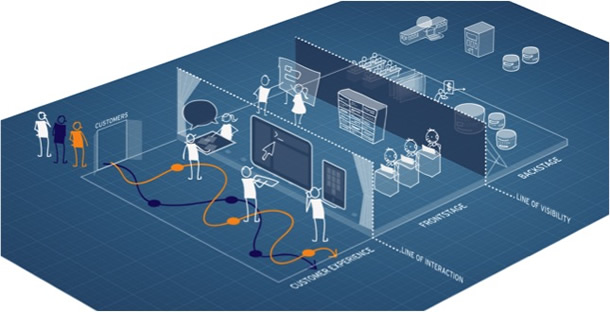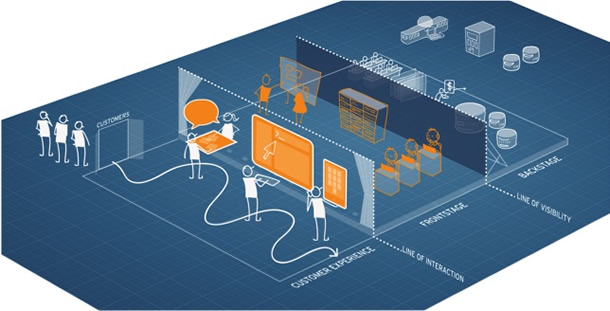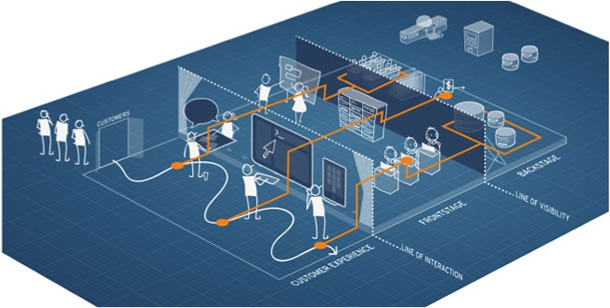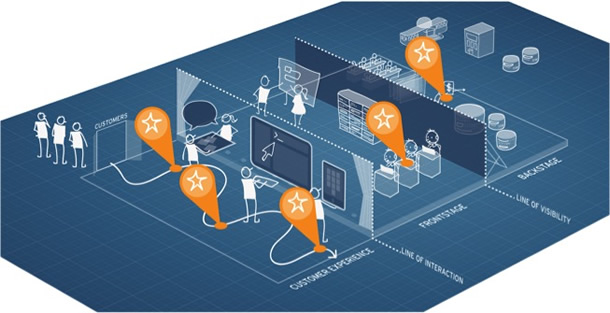“You do what, again?” Service design.
When I describe what I do for a living to someone at a party, I usually get some kind of head nodding around the word “business” or around the word “design.” For those who get excited by the “design” aspect of my career, I typically rein them in by differentiating that, no, I don’t mean graphic design. Nope, not interior design. And no, not web design either. UX design? Well, sort of.
From there, we build mutual understanding of product development. There are designers, engineers, UXers, and product managers. Vigorous head nodding. Then, I say, “What if what we’re building is not a physical product, but an intangible experience, like a service?” More nodding of heads as I explain that there is, indeed, a discipline dedicated to designing experiences for consumption. Welcome to the world of service design.
Service Design: A Break Down
My favorite definition comes from Live Work, a creative agency in the UK that has played a big role in furthering the evolution of service design as a discipline: “Service design is the design of intangible experiences that reach people through many different touchpoints, and that happen over time.”
Bear in mind, service design is not new. It draws upon all the various design disciplines: graphic, industrial, information, and heavily from interaction. What is new is that the focus on the intangible experience means designers must work in new ways to collaborate with organizations. It marries human-centered design with the operational and process capabilities of organizations. That is where the magic happens.
Let’s take a familiar service—an appointment with a new doctor—as an example. There are myriad different touchpoints that influence the consumer’s perception of the service before and after the actual appointment takes place. The chain of touchpoints might start with word-of-mouth recommendations from coworkers, a glance at online reviews, or perhaps the credentials of the hospital or medical group. Then comes booking the appointment. Typically, consumers must pick up the phone during their own business day, say, during a lunch break. And guess what? The doctor’s office is closed for lunch. Then upon arrival for the scheduled appointment, what is the experience of checking in at the front desk? Does the appointment start on time? If not, how long is the wait time? Must the consumer fill out paperwork with the same information they’ve provided before? And so on.
At a high level, service design is the process of matching the experience of the customer journey—from awareness, interest, desire and action—to the internal organizational processes that enable that journey. The customer journey is often referred to as “front stage,” while the internal processes are often referred to as “behind the curtain” or “backstage” (see Figure 1).

The purpose of service design is to improve the quality of the experience, and the application of this purpose can be vast. In the example of the doctor’s appointment, there are many risk points where the consumer could drop off or fail to complete the journey. For example, if the office doesn’t offer an easy and available scheduling process—and that causes annoyance to the prospective patient— that’s a risk point. Mapping out the backstage processes required to enable reliable scheduling provides office management with an artifact that demonstrates how an operational investment will impact the patient experience, and therefore potentially drive revenue.
Why Should You Care?
Our world has changed significantly in the last decade. In the digitized landscape, it’s becoming harder to distinguish between products and services. The original iPod and iTunes service platform are ubiquitous examples of how products and services are being integrated.
That integration provides a huge business opportunity. Eighty percent of the U.S. Gross Domestic Product (GDP) is services, and that number is poised to grow. What’s required to win in services, or “the experience economy,” is a systems-view of functionality and an understanding of how that rolls up into what customers, or users, experience emotionally as they interact with your service/product/brand.
There is also a social opportunity. Co-creation is at the heart of service design. Services are produced in the moment of consumption, meaning that the customer or user is taking an active role in creating the experience he or she is having. Think of what this could mean for the future of healthcare! What if service designers were empowered to influence the context in which patient-doctor interactions take place, such that the patient takes an active role in creating his or her own experience?
What Does That Look Like?
It looks like taking all the lessons learned from agile and lean processes. We must accept that the only thing businesses can count on in today’s fast-paced environment is the ever-increasing pace of change.
In some ways, the idea of customers with agency over their experiences has already arrived. Corporate marketers far and wide have learned to cede control of their brand in the ether of social media. Organizations like Uber and Airbnb have further blurred the boundaries between customer and company. But on the whole, we’ve only begun to scratch the surface of a co-created experience economy. I predict we will see more in the future as technology continues to drive communication channels in new ways. The increasing connectivity of the Internet of Things (IoT) for example, will increase the opportunity and frequency of touchpoints, which would therefore influence the experience, particularly on the business-to-business (B2B) side. This effect can already be seen in the healthcare supply chain industry where more and more inventory is RFID tagged to open up real-time customer experience between suppliers and vendors.
The catch is innovating management so that the user-facing front stage has the full support of the internal-facing backstage to be nimble and to change as the user changes (see Figure 2). Bureaucratic silos, departmental entrenchment and fear of experimentation will cause roadblocks at every turn.

At the Beginning
The foundational tool of the discipline is the service-design blueprint. The blueprint shows both the customer journey and the internal processes together on one page, typically in a grid-like format. As a visual framework, it captures the emotional understanding and the process understanding together (see Figure 3).

What I like best about the blueprint is that it allows companies to expand their notion of the “customer.” There is the end user—the direct buyer, as depicted in the customer journey—but there’s also a vast amount of employees who use the system. The blueprint can be used as a conversation piece for staff and management to help explain the interaction between employees, systems, and customers. Developing empathy for employees is just as important as developing empathy for the customer.
The purpose of understanding how these pieces fit together is to isolate gaps, identify risk points, and generate the desired future state. A current-state blueprint printed large scale in a conference room can be a meaningful strategy exercise. Cross-functional teams can walk through the blueprint and learn which points of interaction can be re-imagined. Then, the blueprint can be overlaid with points of opportunity (see Figure 4).

Conversation is critical throughout the process because service design is all about execution. Once the desired future state has been imagined, there is the task of making that vision a reality. This is where all the “designy” tools shine. Stakeholders will need solid storytelling tools to connect empathically with their users. They also will need a visual or some kind of artifact that captures the aspirational future state. Visuals, wireframes, storyboards, and personas are all extremely valuable tools in execution.
The Bottom Line
Whether internal- or external-facing, service design is about the organizational discipline required to deliver excellent experiences. It is not a “one and done” process; it is ongoing and far-reaching. Successful service design engagements build organizational muscles for both resiliency and graceful execution.
[bluebox]
More Reading
Many practitioners and researchers are doing important work in this field and it is thanks to their efforts that service design is reaching a much wider audience. To read more: (bulleted list)
- 5 Things I Wish I Knew About Service Design (slideshare)
- This is Service Design (slideshare)
- Service Design Network
- Service Design Tools
- Lucy Kimbell
- Stefan Moritz
- Service Jam
- This is Service Design Thinking by Marc Sticdom and Jakob Schneider
- 44Service Design Books list
[/bluebox]服务设计是这样一种流程,它将顾客的整个体验过程 – 感知、兴趣、欲望和行动 – 与能够实现这一过程的内部组织流程进行匹配。为了能在快速增长的“体验经济”中蓬勃发展,组织需要从一种系统的视角去审视他们的能力,并理解这种能力如何转化为顾客与品牌、服务或产品交互过程中的情感体验。
文章全文为英文版서비스 디자인은 고객여정경험 (예: 인식, 관심, 욕망 및 행동, 이러한 고객여정을 가능하게 하는 조직의 프로세스) 과정을 만드는 것이다. 이렇게 빠르게 성장하는 경험경제를 활성화하기 위해서, 조직은 시스템관점에서 자신들의 역할 및 기능들에 대해서 다시 한번 살펴보아야 하며, 고객들이 제품, 서비스, 브랜드 등과 상호작용하는 과정에서 어떻게 감성적으로 경험하는 지를 구체적으로 이해해야 한다.
전체 기사는 영어로만 제공됩니다.Design de serviço é o processo de combinar a experiência da jornada do consumidor – de consciência, interesse, desejo e ação – com os processos empresariais internos que possibilitam essa jornada. Para prosperar no rápido crescimento “economia da experiência”, as empresas precisam olhar para sua funcionalidade a partir de uma perspectiva de sistema e entender como isso influencia emocionalmente a experiência dos consumidores conforme eles interagem com a marca, serviço ou produto.
O artigo completo está disponível somente em inglês.サービスデザインは、気づきや関心、要求や活動といったカスタマージャーニーの経験を、そのジャーニーを実現している組織的な内的プロセスに適合させようとするものである。急速に成長する「経験経済」を成功させるために、組織は、システム的な観点からその機能性を見つめる必要があるし、顧客がブランドやサービスや製品と接する際にどのような感情的経験をできるようにするかを理解する必要がある。
原文は英語だけになりますEl diseño de servicios es el proceso de cruzar la experiencia del viaje que hace el cliente – desde el conocimiento, interés, deseo y acción – a los procesos internos de la organización que permiten que se produzca ese viaje. Para entrar en la creciente “economía de las experiencias”, las organizaciones necesitan mirar sus funcionalidades desde una perspectiva de sistemas y entender cómo eso se junta con la experiencia emocional que tienen los consumidores al interactuar con la marca, servicio o producto.
La versión completa de este artículo está sólo disponible en inglés
